October 24, 2011 Intensely Red Auroras Over Nebraska
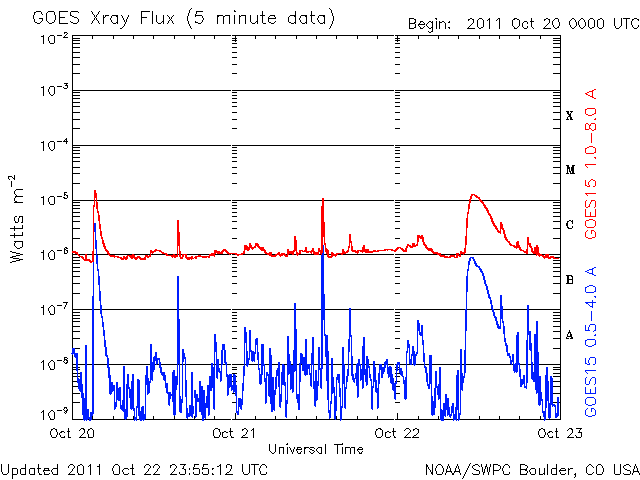
I'll try and explain a few things as people always want to know how to know when to look. First the sun will basically need active sunspots. Sun rotates once ever 27 days. Best if the active spot is mostly facing towards Earth when it lets off a blast. The spots/sun activity goes in an 11 year cycle, with lots of spots near solar max and very few at solar minimum. We've been heading back out of solar minimum for a little while now, so we are now getting more and more spots.
When a solar flare happens from these sun spots, we'll see it here right away basically, in the form of Xrays. Above is an Xray plot from online. Like most things, it is in universal time. So that line, say at October 22 on there, is 0z or 7pm local time here in the central time zone. There is a small hump early on October 22, which was apparently a filament eruption on the sun. A cme or coronal mass ejection was associated with that. Not long after that, you can see a bigger bump half way through the 22nd. That is an M1 flare which is getting bigger. But notice how long it lasted compared to some other flares on that graph on the 20th and 21st. That is usually a good sign a nice CME was associated with the flare. I saw that in progress and was pumped, until I later learned it was from a sunspot on the limb/edge of the sun and would just be sent out into space, not really towards Earth. So I quickly wrote that one off, as is often the case. I never even knew about the filament eruption. C fares don't really get one too excited living in mid-latitudes. Even many M flares won't. X flares are the biggies and will. But heck, I've seen plenty of mostly earth facing X flares that just didn't have much of a coronal mass ejection with them, and they did nothing for auroras. On those graphs though, if you see a long duration event like that last M on there, it's worth getting excited usually, if they are facing Earth much.
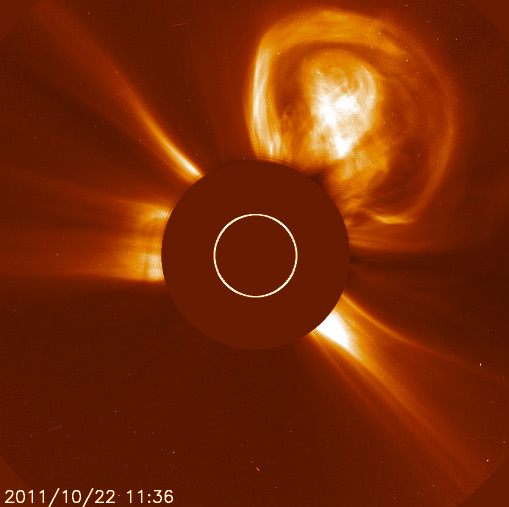
Here is a capture of that M flare and CME in progress. Ignore those jets coming out of the sun, just note that big ball of sun goodies. That was a huge coronal mass ejection. But it was evidently off the sun's edge and not coming for us. Supposedly the filament eruption, much dimmer, was heading for us more-so. It lifted off the sun only like 8 hours before that big cme. They say the cme gave a weak glancing blow first, then the cme from the filament eruption got us just right. Anyway, so first you want an active sun with Earth facing sun spots. Then you need a big eruption to hurl something at our planet. You can see those more or less live with stuff online. But then it is a waiting game, as they'll take a couple days to actually travel here. Some get here damn fast, a day or so, other take their time and a few days. So the easy part is seeing them happen and have something to watch for. Hard part is getting a good hit at night, not middle of the day, and a night without clouds or a bright moon. Even if you get all that to happen, you may still not get auroras, especially the further south you live. I am always watching and trying and I rarely ever see them. Course a lot of this time has been in solar minimum, with far less activity.
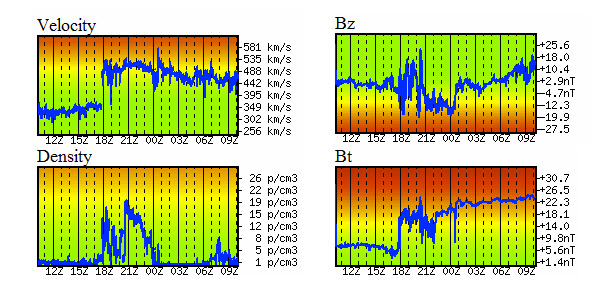
There are various places you can watch for it to hit online. There are spacecraft out there that will register the hit. This is probably the biggest key and most useful aspect of hunting for auroras. Got a cme coming, now time to watch for its impact. I prefer and need nothing more than the plots on http://www.spacew.com/plots.php . If you cursor over those you can see the previous 24 hours. I did that after this was over and screen captured the above at the time.
Just look at velocity. Those are kilometers per second.....super freaking fast. You can see during the morning of the 24th it was calm and steady around 300 km/s. Then at 18z(1pm central time) it has an abrupt increase. The eruption from the sun clearly has arrived. It can be that simple to keep watching when you know it has to about be here and see when it hits. But there will be a lot of these sorta things hitting that don't do much for auroras. So a hit is half the battle. It has to be a good whack and screw up the Earth's magnetosphere. Density is another thing that can be sorta useful. I think of those two as the force of the hit. Faster and more dense the better. I guess the actual particles matter too.
Anyway those two don't tell you all that much about the actual aurora potential. The Bz can and is important to a big degree. It's the tilt of the magnetosphere. A good hit can mess it up and push it south allowing particles to stream on in. You can see at 18z with the hit, it got sent into a bit of a tizzy. North, south, north, south. The more south the better. North and it will be more stable. South can help get displays into further south latitudes. I'm still learning how much any of these can or can't mean. I've not seen much with Bz anything more positive than -10, or so I hadn't till this deal. -15 or -20 and I'm flying the hell out the door. For reference, the extreme storm in 2005 I saw was pegging that at -50, the end of the scale and held it there.
Bt I don't understand at all. Some "total" potential number. The thing about this event was the crazy intense part came at 8:30, which is 1:30z on those. Bz at that time on those is positive. But what I think it is, is that there is a small time gap as the spacecraft is out there a ways. I don't really know. All I know is I can't see how that could jive otherwise. It really wound down after the red surge too and the graph would then make perfect sense as it stays positive Bz on there. The crazy thing to me this time though, is even when it was not as intense, it was clearly still visible to the eye and all the while the Bz was positive. Basically there will be a mix of general uses on this stuff. Pretty much the more south the Bz gets, the more intense the show can get. While it was there after the red crazy part, all night basically, it was never remotely intense looking then...and according to the plots it was positive Bz that whole time. But the same time Bt was in the red the whole time.
Anyway onto the pictures and main part of the account.
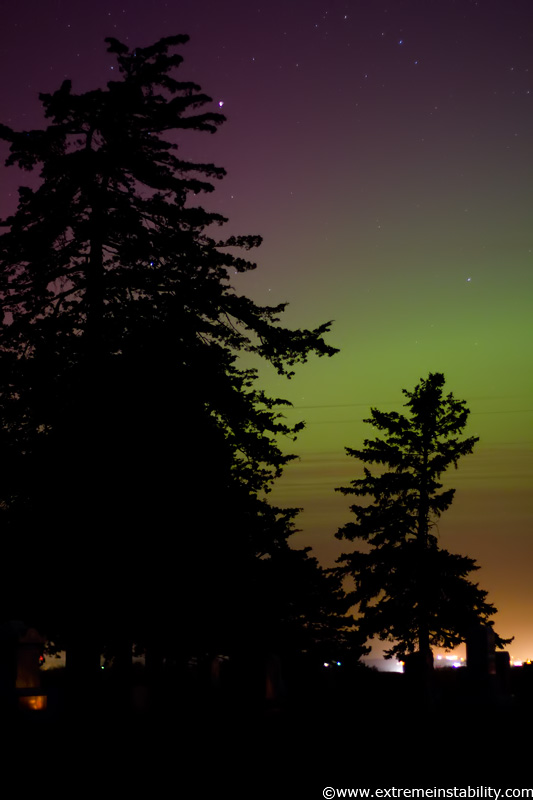
Big thanks to Tyler Burg for the phone call or I'd have completely missed this event. I flew out the door soon as he called. I was going to head over into IA like always, but I remembered highway 30 is currently closed for them to remove flood bags. So I turned north, wondering where I was going. I then remembered the cemetery up there a few miles. They are kinda nice because unlike random gravel roads you really don't have to deal with cars wondering what you are doing as they drive by.
Soon as I cleared the town lights I could see the glow to the northeast, this while some twilight was left to the west. They looked similar, though it obviously wasn't supposed to be over there if it was just twilight stuff...so pretty much knew right away I was seeing auroras, as I drove north. I held the camera as I drove, at 3200 ISO, F1.8 for 1 second to verify and yep, nice and green out there. Pedal goes down a little harder.
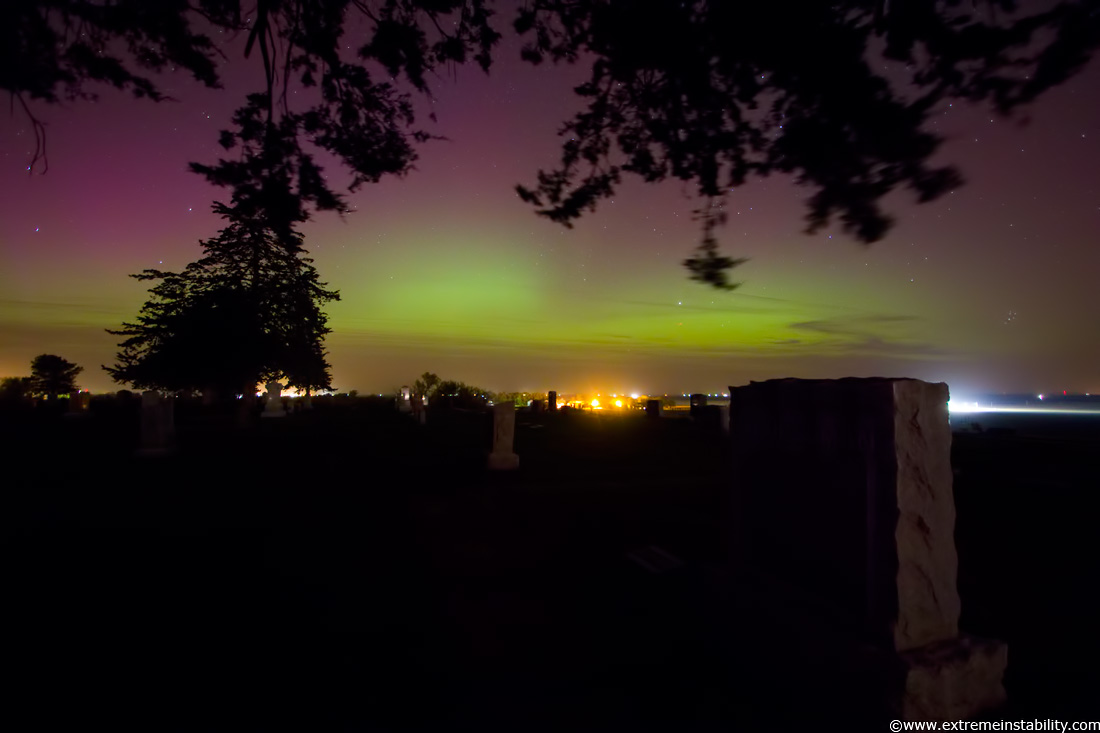
At first it took pretty high ISO's to get. Mostly just a fairly faint glow, but the best glow I'd seen in years, since 2006 anyway.
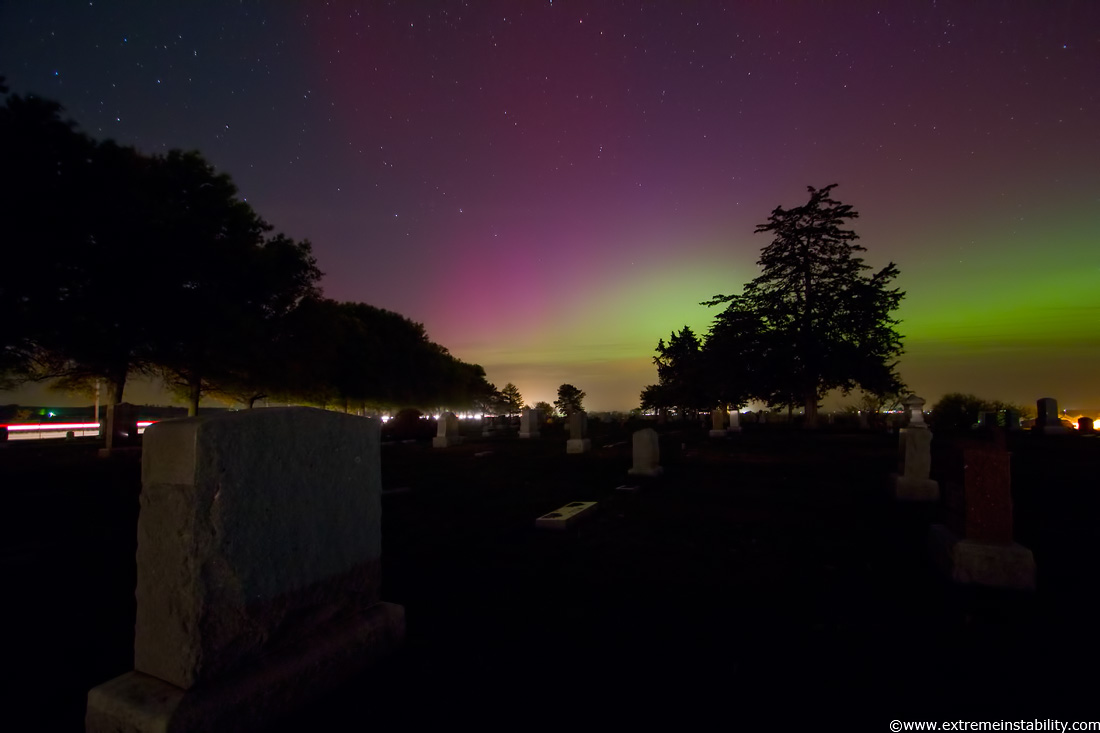
I had a bit of an odd deal happen when I first got here. Some of these have lights near them, as in small colored lights. This is right next to the highway, which you can see in the above on the left. I'm in there in the dark when all the sudden, plain as day, small lights were freaking moving! I'm like, what the hell and rapidly freaking out a bit. Then I saw what it was, someone on a damn bicycle riding down the shoulder! What the hell are the odds. The lights looked the same lol.
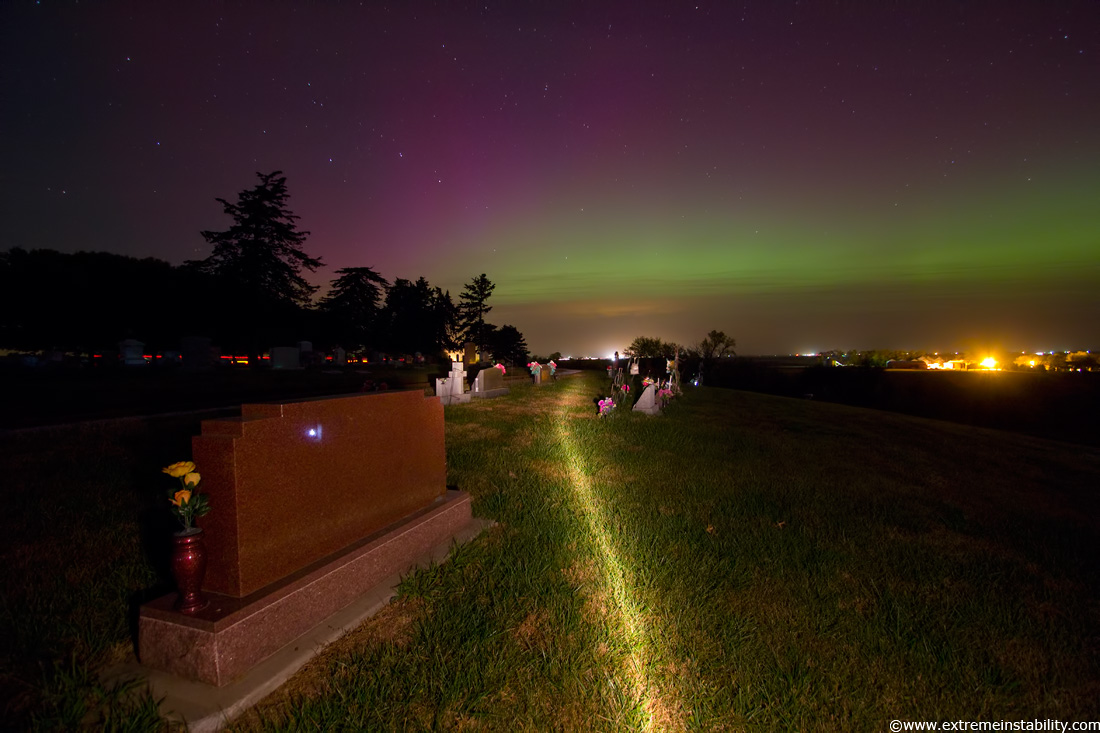
Messing around with the flashlight a bit.
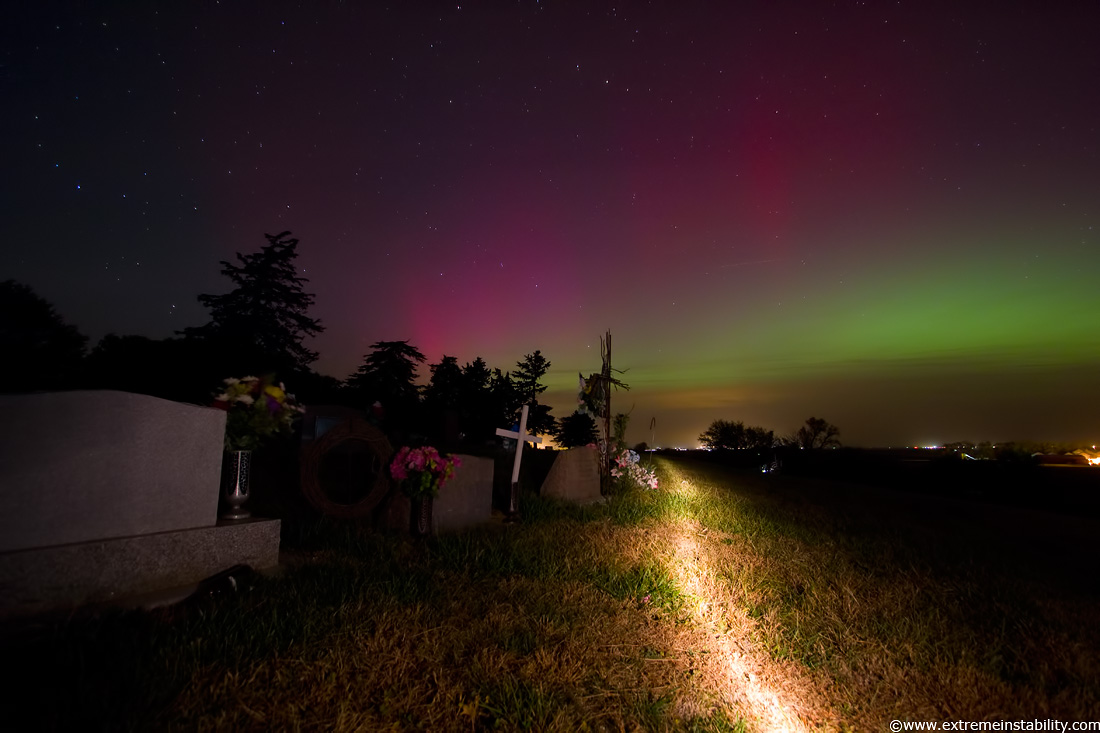
Right about now, around 8:30 pm central time, the first signs of the coming red storm showing up. This would be some of the biggest and brightest reds I've ever seen. It was already a complete surprise to even have any fashion of auroras and it was about to go completely insane.
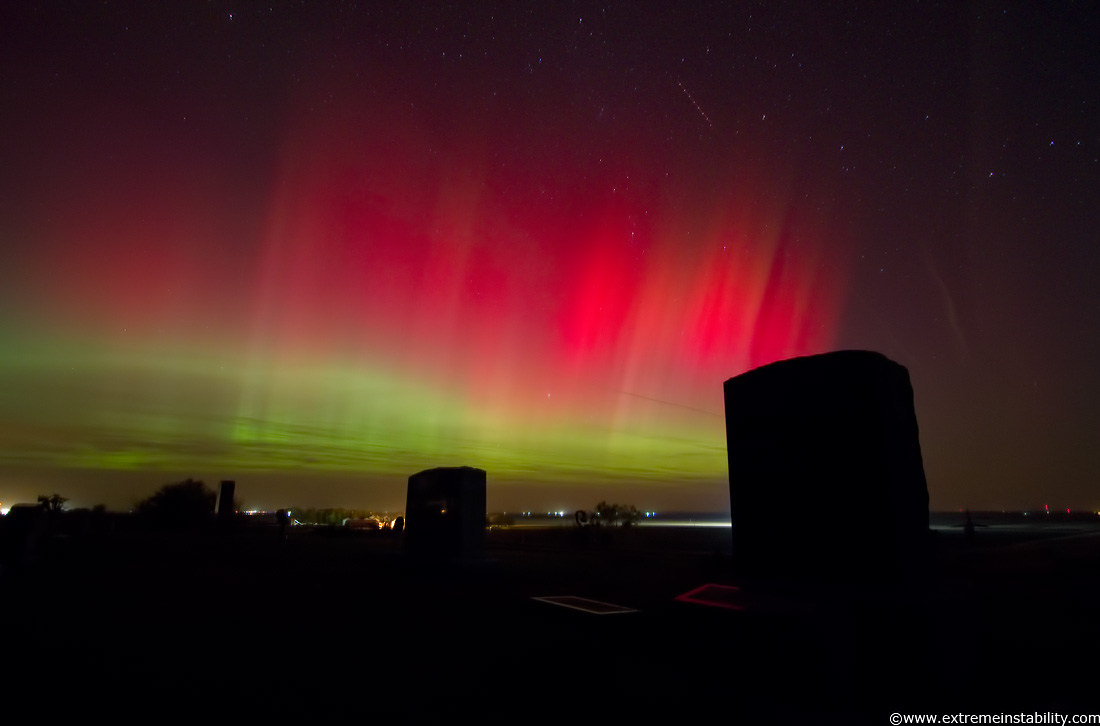
Hello! It was funny, I had phone problems, simply too many people calling and me calling too many. Get done with one as someone else calls. But during this 10-15 minute complete red madness storm part, the phone was dead silent. It was clear everyone was now too captivated to be on their phone.
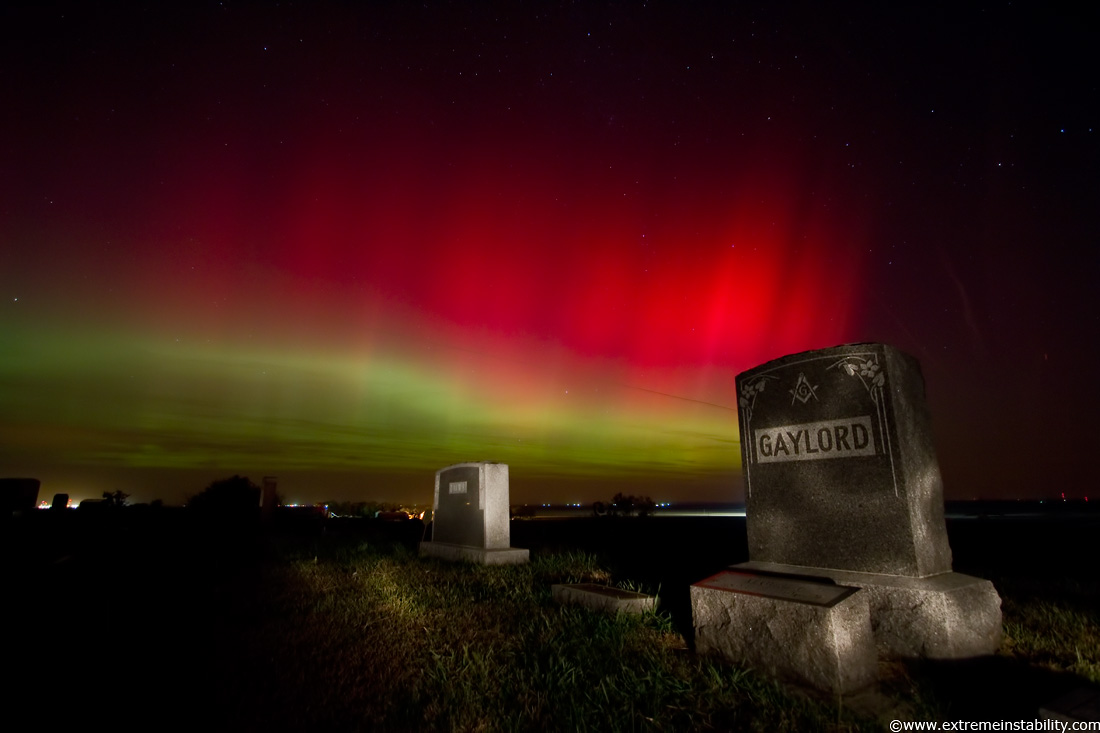
Just like when storms go crazy, it's so important to shoot while it's crazy and do so fast. Don't dink around and think it will last any longer, because many times it will not. Auroras just no different than chasing storms in that regard.
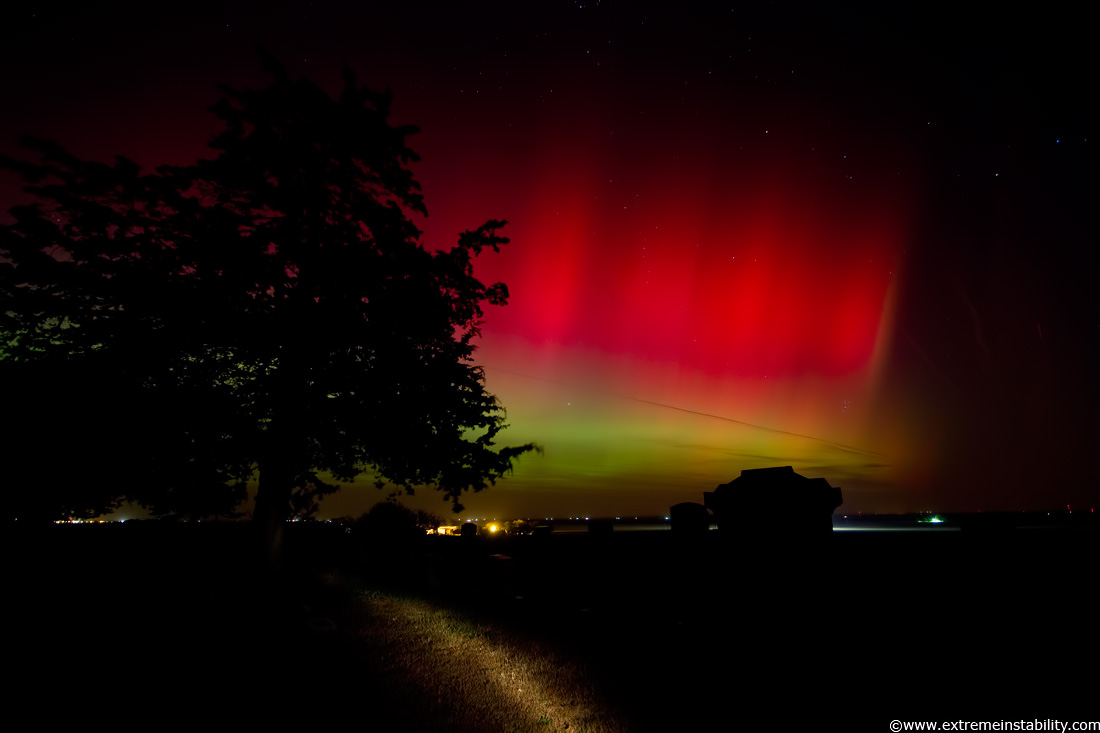
I think one of the few times I dropped the ISO down to 400. I've been dying for a good show again, as in some ways I'd screwed up the 2 buggies in 2004 and 2005. 2004 I had the original kit lens which sucked. It was not in focus either, so many of those are a lost cause. Then in 2005 I trusted the LCD too much and they are all under exposed. This time I live view focused the 10-22 EF-s and made sure to not under expose, which is pretty easy on auroras. Though this insane red event was very exposure friendly, or easy. This was being seen as far south as Alabama and New Mexico! Reds are much higher up in the sky than the greens. Even more rare than reds are violets, which were seen in the 2005 event.
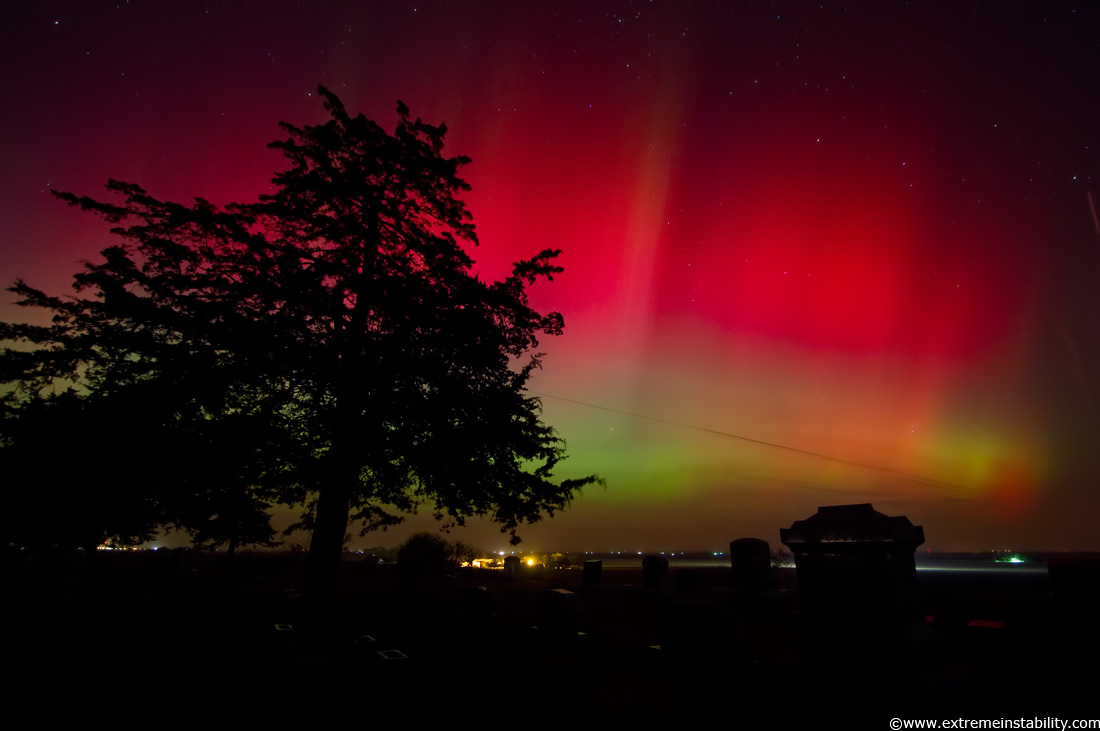
This is why it's worth staying out when the auroras are simply just there but not that crazy to look at. These outbursts will often happen and be highly worth being out for. Outside of this 10-15 minute spurt, it wouldn't have hurt too bad to miss things. This time frame was simply amazing though.
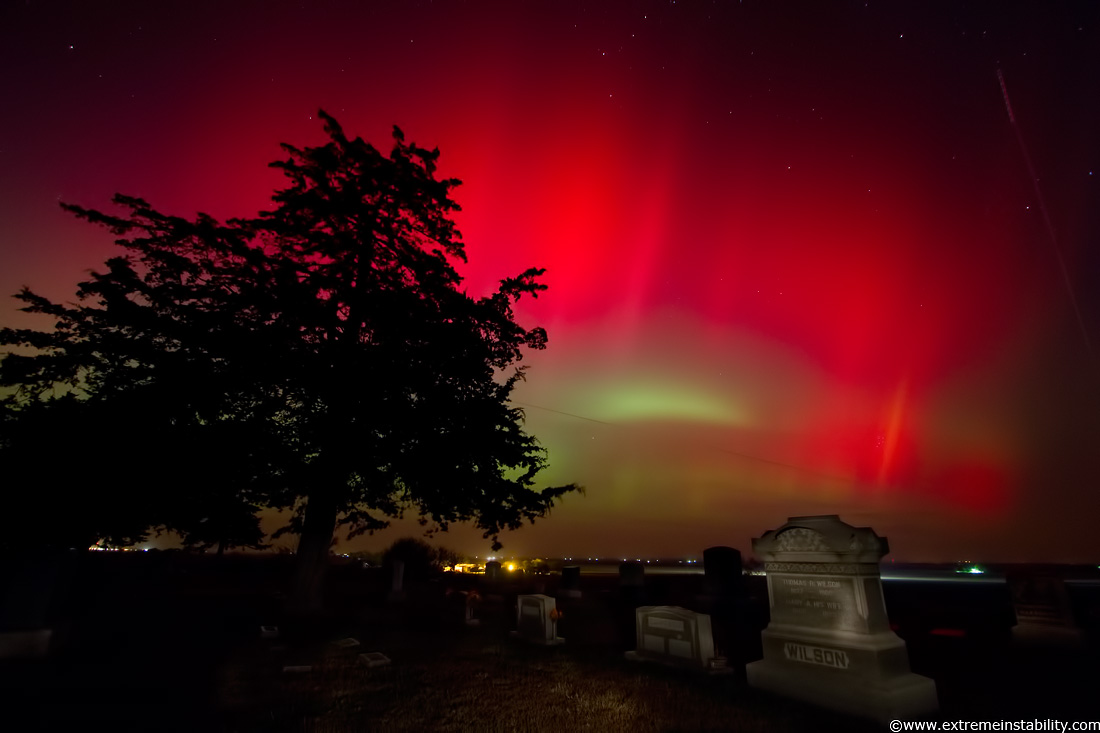
It sorta sucks that you just don't have more time to do shots with such a display. Just look at the damn jet contrail in the upper right over there. Freaking red. You had enough time to make sure you were getting something of it, something level and whatnot. It'd have been so nice to have had more time to try other stuff. 10 minutes just flies the hell by. You move the camera and you are again trying to level it and whatnot, which takes some time in the dark. Often have to wait for inner camera lights to go back off so you can see the horizon again.
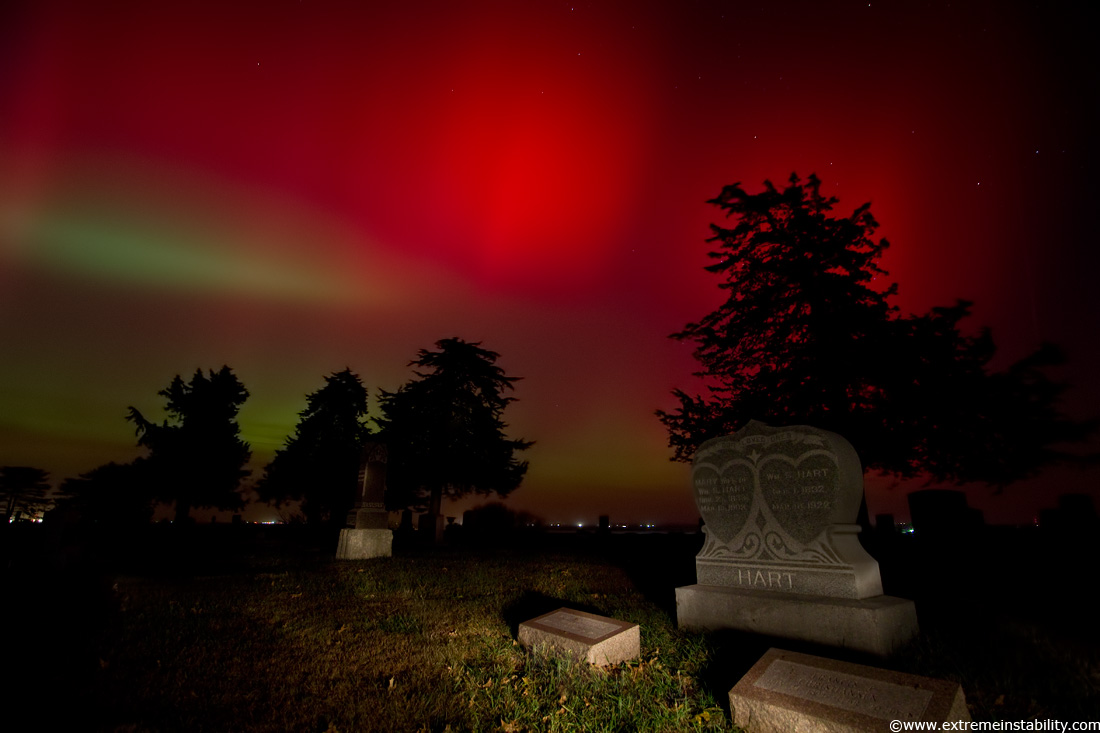
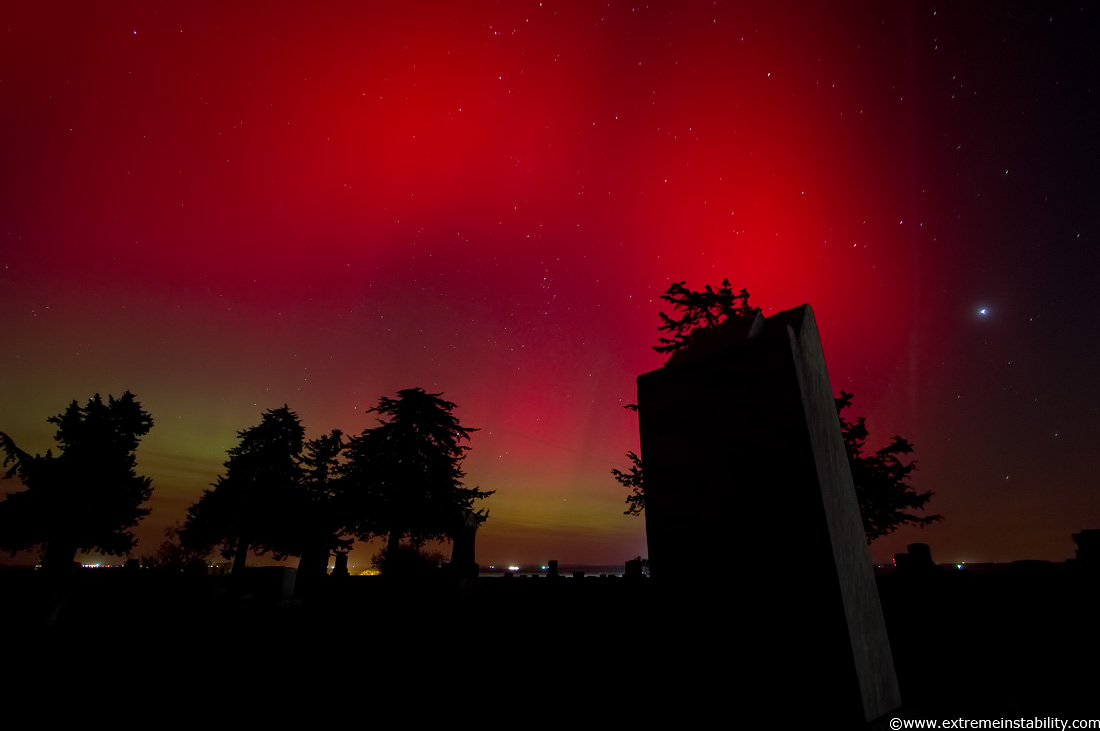
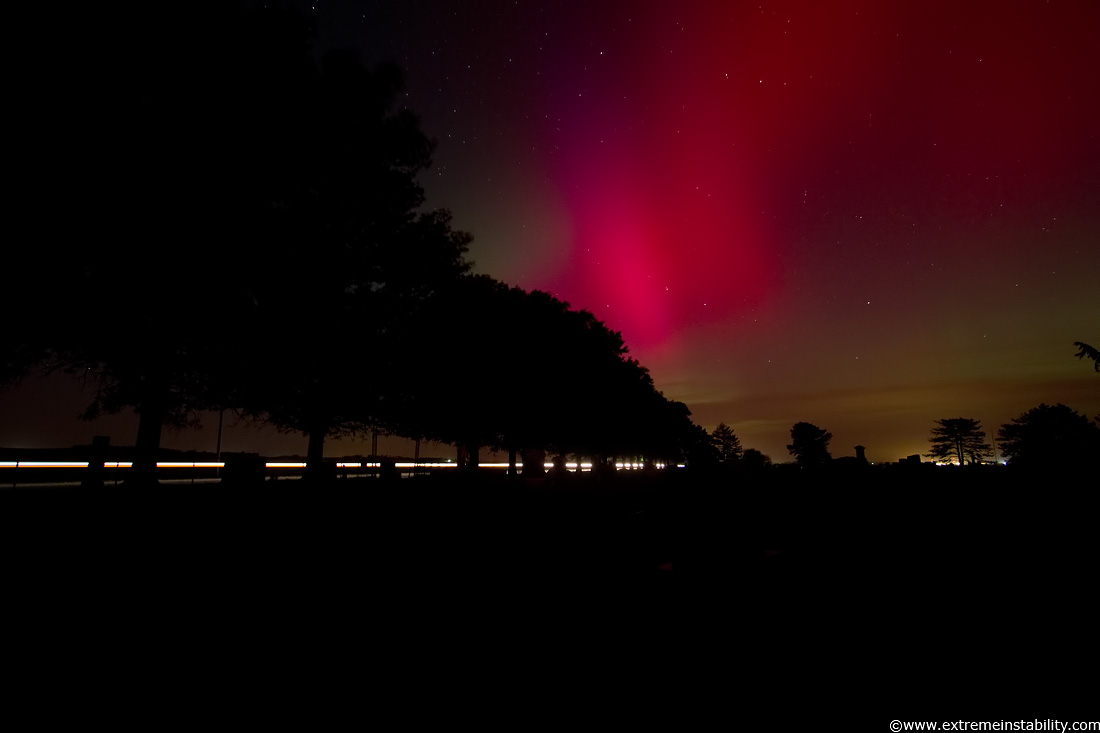
Already it was showing signs of fading. :(
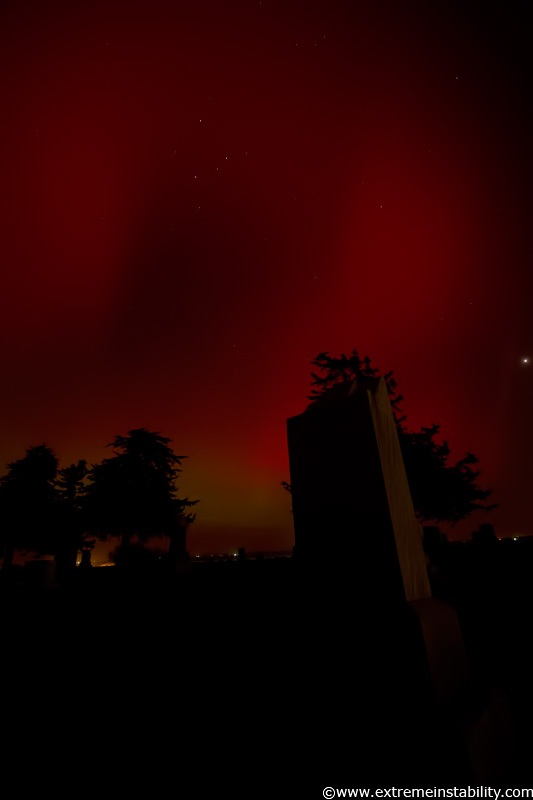
Going pretty darn fast now. It was cool how it did leave that red glow in the air a while after that.
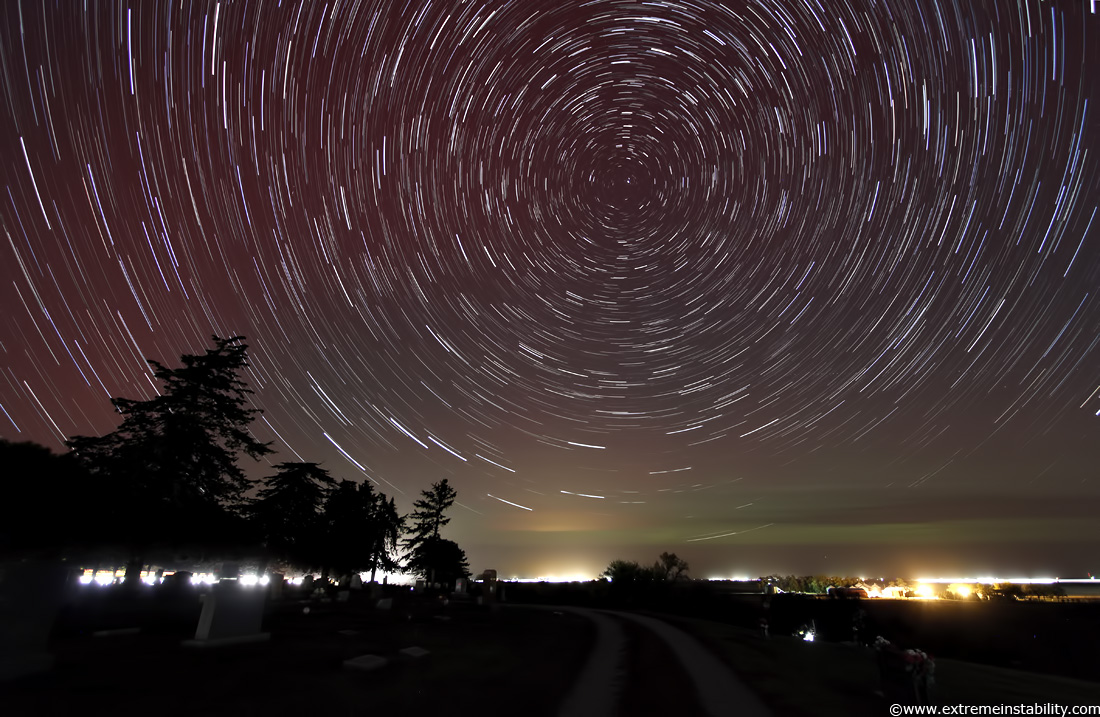
Was kinda annoyed to not have some more spurts happen while I started the star trail. But I'm not complaining! Thank you mother nature and thank you Tyler for the call!







